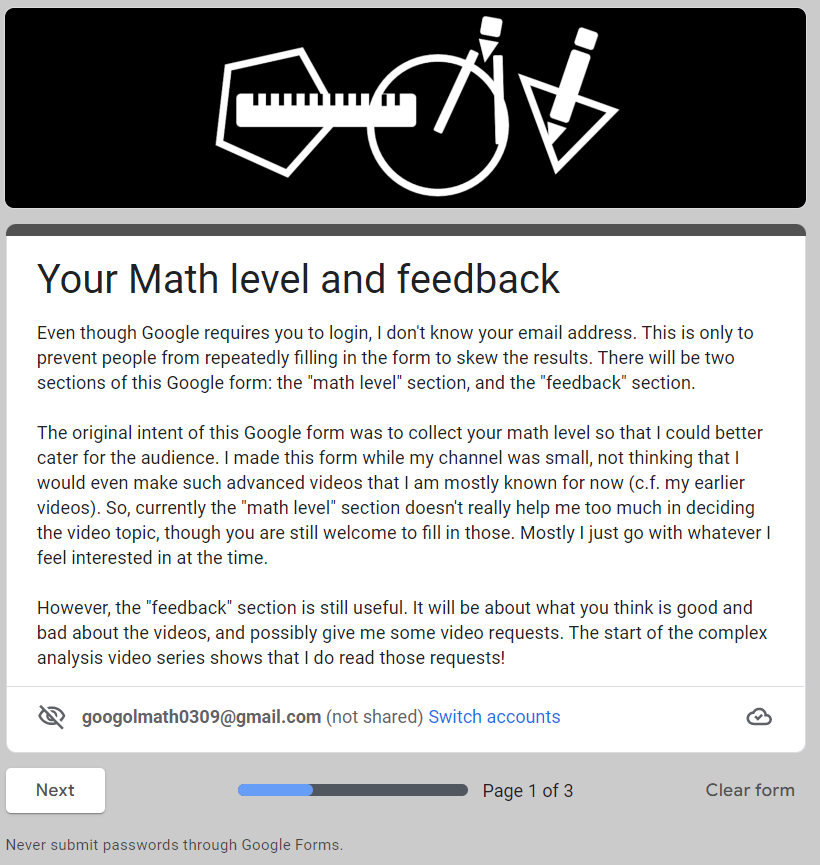1. How do you make your videos?
Perhaps surprisingly, I use PowerPoint to make my videos. Essentially each video is a screen recording of a PowerPoint slideshow, and I used Shotcut, a free video editor, to combine the screen recording and my audio (recorded from my phone) together to form the video.
For the majority of animations, I use GeoGebra, another free graphing software. The “animations” can be done in GeoGebra with a slider. I export it as a GIF file, and place it onto the PowerPoint slides. You will be surprised how much you can do with GeoGebra!
2. Can you recommend some resources to learn [insert topic]?
Here is the thing. Cambridge is so reliant on lectures (and more importantly, supervisions, perhaps called tutorials / seminars in other places), that I have practically never used a textbook ever. The only time I have come close to one is Visual Complex Analysis by Tristan Needham, which I thoroughly enjoyed, and is the backbone of my complex analysis video series. So I am sorry that I just could not recommend any resources / textbooks, simply because I personally haven’t used any of those.
If you are interested in how Cambridge lecture works, here is Dexter’s notes, a set of typed lecture notes taken by Dexter Chua. For supervision, you will have to be a student in Cambridge.
3. What is the level of math that you assume in your videos?
I recognize this problem early on and decided to make a Google form for viewers to tell me their math levels. There are many flaws to this, e.g. people underestimate what they know, too few responses.
With the increase in math levels in my videos, this problem is getting worse, and there are many people who think I’m going too quickly, and many thinking otherwise. I couldn’t cater for everyone, and currently the benchmark is my past self, specifically myself before learning the topic in the video. Usually that means a math undergraduate level.
I welcome you to translate my videos. This is the procedure:
Write me an email (you can see in the contact section) stating that you want to translate into which language.
I would be able to give you the script (in English), and a Google translated version, all with time stamps.
You can translate into your language and email it back to me.
I can then upload the subtitle file to YouTube!
This is because YouTube has, extremely regrettably, decided to turn off the community captions feature.
As for reposting, definitely not on YouTube without my permission, even if you have done translations and/or dubbing. With my permission, I would possibly be okay with you doing dubbing on your YouTube channel, but I will have to check before you publish it. As for other social media platforms, again ask for permission. Most likely I would be okay if you do translations yourself (not automatically generated), but if you simply repost my videos elsewhere, this would never be allowed.
In other words, please do not repost my videos without my written permission.
I am sorry that these have to be so strongly worded, but I really do not like people taking credit for my work.
4. Can I translate and/or repost your videos elsewhere?
First thing, try it. Many people stress over the first video, but chances are, nobody is watching! Experiment with your first videos! This also goes to the second tip: be sure you like making videos. This is more important, but unless you’ve tried making a video, you don’t know the difficulties in it, which might influence how much you enjoy the process.
There is also this video series by Tom Scott, but that does not just apply to YouTube.
5. What advice do you give to YouTube channels starting out?
6. How do I contact you?
Even though I will probably read DMs on social media, it is much better to email.
Email: cheungkhtrevor@gmail.com




